For the fourth year, New Jersey’s elementary, middle and high school students dazzled attendees and judges at Workshop with their ideas, creativity, knowledge and enthusiasm at the STEAM Tank Challenge, the student invention competition which is jointly sponsored by the New Jersey School Boards Association and the U.S. Army.
The winning entries included inventions as varied as expandable dress shoes for children, edible toys for dogs, and an electronic device that authenticates camera frame rates so video can successfully be used in criminal prosecutions.
STEAM Tank, which was modeled after the popular television show, “Shark Tank,” was developed to provide teams of students the opportunity to tackle real-life problems, and design and create products that address those problems. The competition asks the district teams to invent something new, modify an existing product, or identify a situation or problem that needs resolution. Teams are provided with criteria, and a panel of experts judge their designs and/or solutions. Teams presenting must consist of at least two, but no more than five, students and at least one educator.
This year, more than 550 student teams—and an estimated 2,000 students—entered the program. Students presented before judges in regional competitions held in spring 2019, then 90 teams went to the finals, which were held at Workshop in October in Atlantic City.
The nine winning teams of the 2019 STEAM Tank Challenge were announced on Nov. 7, during a ceremony at the NJEA Convention in Atlantic City.
“The 2019 STEAM Tank Challenge engaged approximately 2,000 students, parents and teachers in a valuable education experience,” said Dr. Lawrence S. Feinsod, NJSBA executive director. “By working as a team, conducting research and solving problems as they arise, students learn how to create, innovate and meet challenges.
“NJSBA and our partner in this effort, the U.S. Army, thank the NJEA for demonstrating its support for the program by once again hosting the awards ceremony.”
Dozens of judges, including New Jersey Education Commissioner Lamont Repollet and Assistant Commissioner Cary Booker volunteered their time to score the student presentations. The PSEG Foundation donated prize money that will go to the winning teams in each grade level. Dale Rosselet, vice president for education for New Jersey Audubon, provided invaluable support.
The 2019 winners are:
HIGH SCHOOL DIVISION
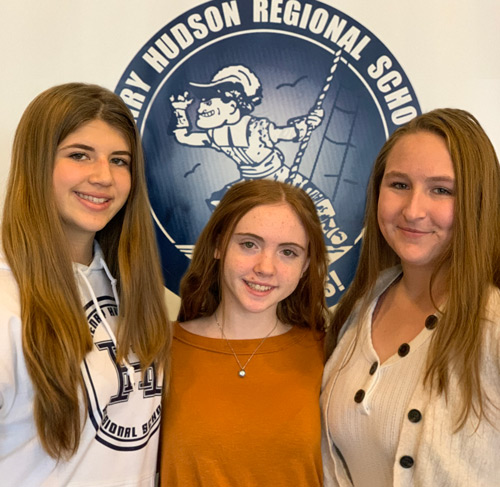 Left to right, Samantha Akers, Zoe Brodbeck and Rebecca Bertekap, of the Henry Hudson Regional High School in Monmouth County
Left to right, Samantha Akers, Zoe Brodbeck and Rebecca Bertekap, of the Henry Hudson Regional High School in Monmouth County
FIRST PLACE “Puppyable,” Henry Hudson Regional High School, Henry Hudson Regional School District
Anyone who has ever had a dog knows that dogs have a tendency to chew things.
Henry Hudson Regional High School students Samantha Akers, Zoe Brodbeck and Rebecca Bertekep all have dogs, so when they were brainstorming for ideas for a STEAM Tank project, the concept of an edible dog toy resonated with all of them. They knew that if a dog shreds a toy and consumes the stuffing inside, it can cause a gastrointestinal blockage that can require surgery.
The students decided to make a dog toy that would be digestible; the fabric is make from hemp fiber, while the stuffing is made with milk protein and dehydrated pineapple.
The “Puppyable,” invention captured first prize in the high school division of STEAM Tank this year. The girls have a patent pending on the product, and plan to sell them for about $7 apiece. They already impressed one customer — one of the STEAM Tank judges liked it so much, she bought one of the toys.
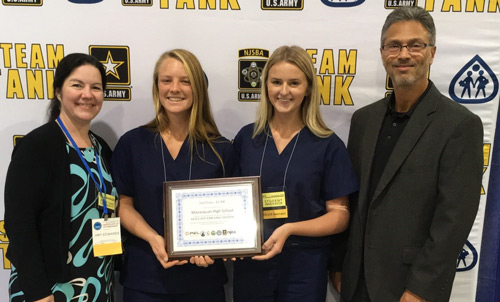
Pictured here are RaLee Wall and Jane Hamilton with Amy Edwards (left), Manasquan High School Academy of Engineering Director, and John Henry (right), NJSBA iSTEAM and sustainability specialist.
SECOND PLACE “EcoCast Chilling System,” Manasquan High School, Manasquan Public School District
For this year’s STEAM Tank Challenge, a Manasquan High School team decided to further refine an invention from last year, which took second place in the 2018 competition. Team members RaLee Wall and Jane Hamilton believed that they could add a useful feature to that earlier model.
Their invention, the “EcoCast Chilling System” is a refinement of the “EcoCast,” a biodegradable 3-D printed, multilayered cast for compound fractures. The Eco Cast is made of a decomposable plastic (with an inside lining of gauze made from bamboo), rather than fiberglass and plaster, which will not decompose in a landfill.
However one aspect of post-surgical care that the EcoCast did not address was the swelling that takes place in an injured limb post-surgery, and how that swelling affects limb size. Current methods of stabilizing broken limbs, post-surgery, restrict the application of ice or cold compresses to the site. The team’s solution to this problem extended the design of the 3D-printed EcoCast to include an integrated fluid chilling system operated via a unique manifold control system. This allows for compensation in limb swelling, application of cold compresses where they are needed most, and decreased patient pain, all of which will help people return to daily activities sooner.
One of the team members, RaLee Wall, recounted that when she was in fifth grade, she broke one leg, and a year later she broke the other leg. Both times she was in a cast, she thought of the cast materials that were destined to end up in a landfill, which prompted the development of the EcoCast. She also had a problem with her leg swelling at different points in the casting process, and having to figure out how to get ice packs inside the cast. Towards the end of her recovery, she experienced loosening of the cast, as a result of some muscle atrophy, and the cast was not as snug as it should have been. All of those experiences prompted the team to develop the EcoCast Chilling System.
Both team members are aiming for careers in health care; Jane Hamilton will be a pre-med major in college next year; while RaLee Wall will study to become a physician assistant, possibly in orthopedics. Perhaps both girls will someday end up using their own invention on a patient.
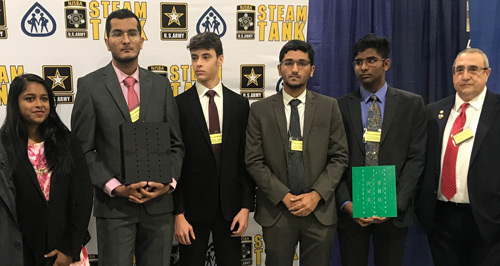
Pictured, from left to right, are Varsini Dhinakaran, Manas Harbola, Thomas Weatherbee, Mehraaj Tawa and Aditya Vidyadharan with instructor/engineer Enzo Paterno.
THIRD PLACE “Frame Rate Authenticating Tool,”Middlesex County Academy for Science, Mathematics, Engineering & Technology, Middlesex County Vocational Technical School District
Sometimes poor video quality of street cameras makes it more difficult for law enforcement in criminal investigations to process the recorded video when analyzing crime. While law enforcement personnel are provided with the latest in video-analyzing software, extracted data is often inadmissible in court due to inconsistencies in camera frame rates. For instance, frame rate is imperative in gauging the time it takes for a vehicle to travel a certain distance between frames in a recorded video.
The Middlesex County Academy for Science, Mathematics and Engineering Technologies was approached by a mobile forensics detective from the Middlesex County Prosecutor Office, Detective Brandon Epstein, to devise a solution. The students designed the product with the help of their instructor, Enzo Paterno. This innovation has been named the Frame Rate Authenticating Tool, (FRAT). After the team tested and refined the device through a series of prototypes, Detective Epstein successfully field-tested the FRAT innovation in three official cases. One of the cases resulted in a trial.
The five students on the team, Varsini Dhinakaran, Manas Harbola, Thomas Weatherbee, Mehraaj Tawa and Aditya Vidyadharan, worked on their project for approximately two and half years. All five are seniors in the electrical and computer engineering technology (ECET) program. The students currently have a provisional patent for the design and are working on trying to mass produce the item; they are speaking with nonprofits that might be capable of manufacturing it.
MIDDLE SCHOOL DIVISION
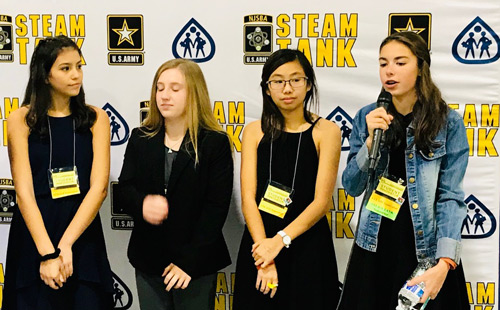
Left to right, Kira Zimmer, Cassidy Brennan, Samantha Ngo and Caitlyn Zito of Howell Middle School South describe their project, “Cell Cycle.”
FIRST PLACE “Cell Cycle,” Howell Middle School South, Howell Township Public Schools
Four eighth-grade students from Howell Middle School South devised an ingenious mobile game that encourages recycling, “Cell Cycle.”
“Over a million sea creatures are killed each year by plastic and plastic is beginning to get into our drinking water and contaminate it,” said Cassidy Brennan in an interview with NJSBA’s Ray Pinney. “We decided to make a game out of it because nobody really has to recycle, so we thought ‘why don’t we make it fun so people want to recycle,’” Samantha Ngo added.
The Cell Cycle app allows the user to scan the bar code of products put in recycling bins. Kids add points to their daily and weekly score by scanning the products they are recycling, and they compete with their friends.
According to the students, the business model for the app involves putting it on various app platforms, and selling advertising on the app to local food stores and businesses.
The team worked on the app for about a year; even after winning, they continued with their efforts. “We would like to take it to investors and get it coded and finish it,” said Cassidy Brennan. Teammate Caitlyn Zito is similarly determined. “We are in contact with a mobile app developer, and he is providing us with the steps it takes to release this product, so it’s not like it ends here; we will keep going.”
Second-place winners Alicia Bradley, Rebecca Mazzola, and Alyson Geyer, of Pitman Middle School in Gloucester County.

Second-place winners Alicia Bradley, Rebecca Mazzola, and Alyson Geyer, of Pitman Middle School in Gloucester County.
SECOND PLACE “ARA 200,” Pitman Middle School, Pitman School District
Alicia Bradley, Rebecca Mazzola and Alyson Geyer from Pitman Middle School were inspired to come up with an invention to help bolster school safety and security after they learned that someone tried to enter one of the locked side doors in their school.
The three students worked for about a year to create a prototype for an x-ray machine to conduct locker checks for possible weapons that could lead to threatening school situations. Their project was called “Locker Safety,” and their invention is named the ARA 200 (ARA stands for “Alyson, Rebecca, Alicia”).
The ARA 200 is an x-ray device that is attached to a robot. The device can travel down a hall and scan lockers, while being controlled remotely by a tablet with a joystick. The x-ray portion is also detachable in case it is necessary to scan something else. The team is planning to modify the invention by installing a hydraulic lift so that the x-ray device can move vertically, and developing a robot that can travel more quickly.
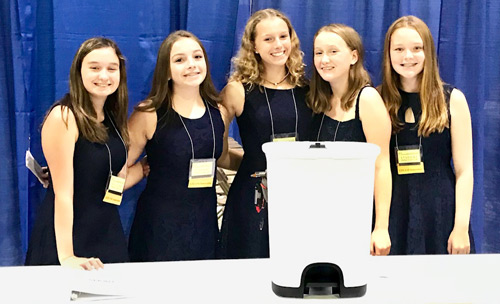
Third-place winners (left to right) Kayley Hassett, Allison Zurey, Skyler Starr, Emma Diroff and Jami Van Orden, of Howell Middle School South in Monmouth County.
THIRD PLACE “Smarty T,” Howell Middle School South, Howell Township Public Schools
The third-place prize went to a team of Howell Middle School South eighth-grade students. Their innovation – “Smarty T” is a trash can which uses sensory technology to determine if an item being thrown away can be recycled. By alerting the person throwing the item away as to whether something is recyclable or not, items are sorted at a consumer level, and non-recyclables are kept out of landfills.
The students began to think about an invention like this after learning about the adverse effects of plastic pollution in landfills. Plastic water bottles, for example, are trapped under immense pressure in the landfill and rainwater absorbs the water-soluble compounds in the plastics. Those chemicals can enter groundwater, soil and streams.
The team estimates that the Smarty T would cost about $50-$60 at a consumer level, and believes that people would happily invest in such a device to help prevent pollution. The group has spoken with someone who works at a custom trash can manufacturing company, and is hoping to manufacture a small quantity of the cans and release them to small retail stores to gauge public reaction.
ELEMENTARY SCHOOL DIVISION

Winning first place for their project “Stretchers,” from left to right, are Casey Reinknecht, Madison Vigliotti, and Reese Ertel of the Aldrich Elementary School in Howell, Monmouth County.
FIRST PLACE “Strechers,” Aldrich Elementary School, Howell Township Public Schools
Aldrich Elementary School students Madison Vigliotti, Reese Ertel and Casey Reinknecht took first place in the elementary school competition for their invention “Strechers,” an expandable dress shoe for children. They worked with the Skechers shoe company to make a prototype.
“Our product is a shoe that can expand three sizes so you could use them for multiple years,” Madison Vigliotti told NJSBA.
Children’s feet grow about 1 mm in length each month, according to the team. They got the idea of expandable shoes from looking at expandable roller skates. The shoe they developed can increase by two sizes, so a child’s size 2 shoe can increase to a size 3 or size 4.
The shoe itself has elastic on the sides, and to change the shoe size, a wearer takes out the inner sole, changes the length of the sole by adjusting it using pegs and then puts the inner sole back in. The team first thought of using a gear system to change the size, but found that simple pegs worked better.
They reached out to the Skechers shoe company and ended up talking with the vice president of girls footwear design and a Skechers designer, and the company made a prototype for the team from their drawings.
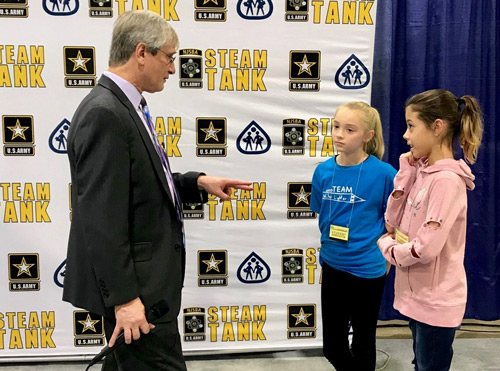
Placing second for their project “Writer Lighter,” Payton Fleming (blue shirt) and Madison Burgos of the Raritan Valley Elementary School in Hazlet, Monmouth County, discuss their project with Ray Pinney of the NJSBA. Not pictured are “Writer Lighter” team members Jeannette Therien, Caden Craig-Wedmore, and Ella Herman.
SECOND PLACE“Writer Lighter,” Raritan Valley Elementary School, Hazlet Township Public School District
The Writer Lighter, a pen with a built-in light, uses kinetic energy (a light using this is sometimes called a “Faraday flashlight”) to power its light. The resulting light can help a soldier without access to electricity, or a person whose home lost power, write.
The team was inspired to devise their invention by thinking about members of the military who might want to write to their families and friends while they are deployed, as well as by others who might not have access to electrical power.
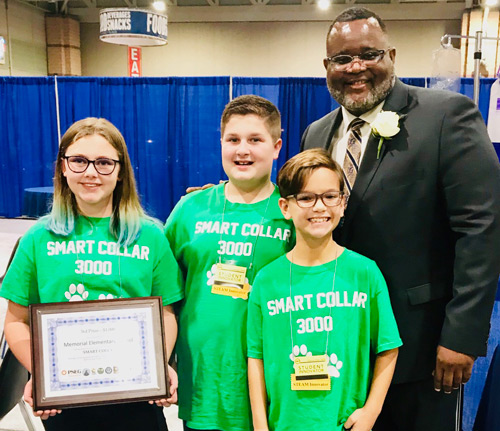
Taking third place, from Memorial Elementary School in Howell, are (left to right) Ashley Hansen, Nicholas Djoulia and Aiden Velez.
THIRD PLACE “Smart Collar 3000,” Memorial Elementary School, Howell Township Public Schools
When Ashley Hansen, Nicholas Djoulia and Aiden Velez sat down to talk about possible ideas for STEAM Tank entries, their thoughts turned to doing something for pets using technology.
The eventual result was the Smart Collar 3000, a dog collar that help locate a lost dog. The collar has a transmitter tile on it, and if a dog is missing, the owner can use a cell phone app to locate the dog, and can also prompt the collar to make a noise.
The fifth-grade students, who worked about a year on this project, estimate that the collar would cost about $120.
STEAM Tank 2020 has attracted a new record number of participants—657 team applications, representing more than 2,500 students. Due to concerns about the COVID-19 pandemic, NJSBA is making plans to conduct the regional competition through videoconferencing. Student teams will be notified and provided with more details in the coming weeks.
